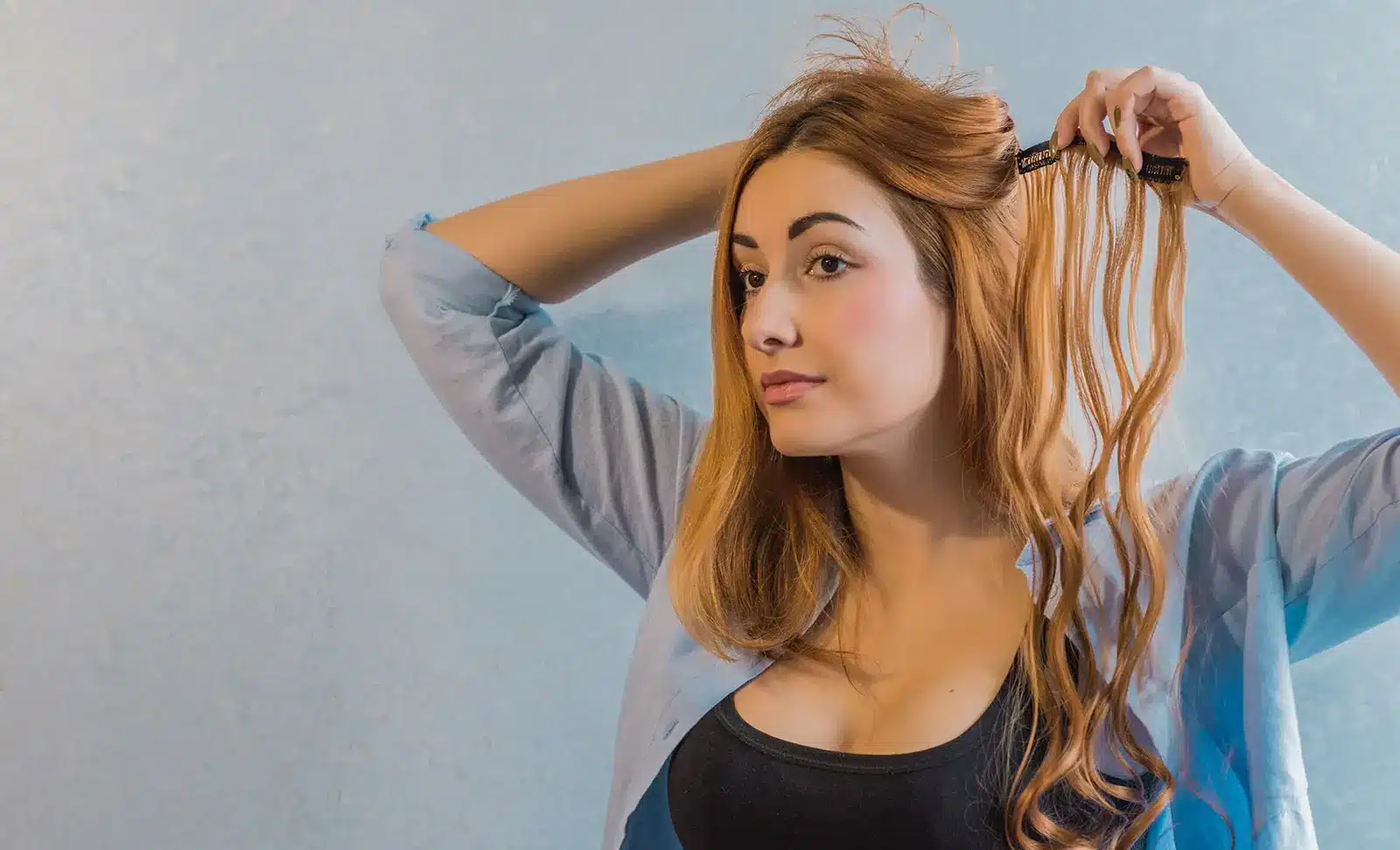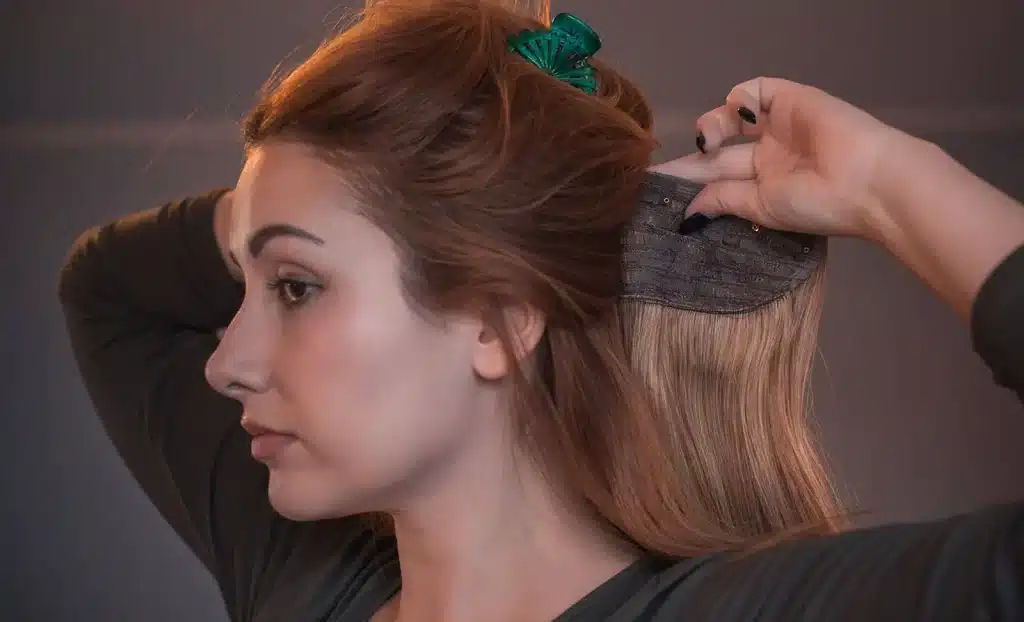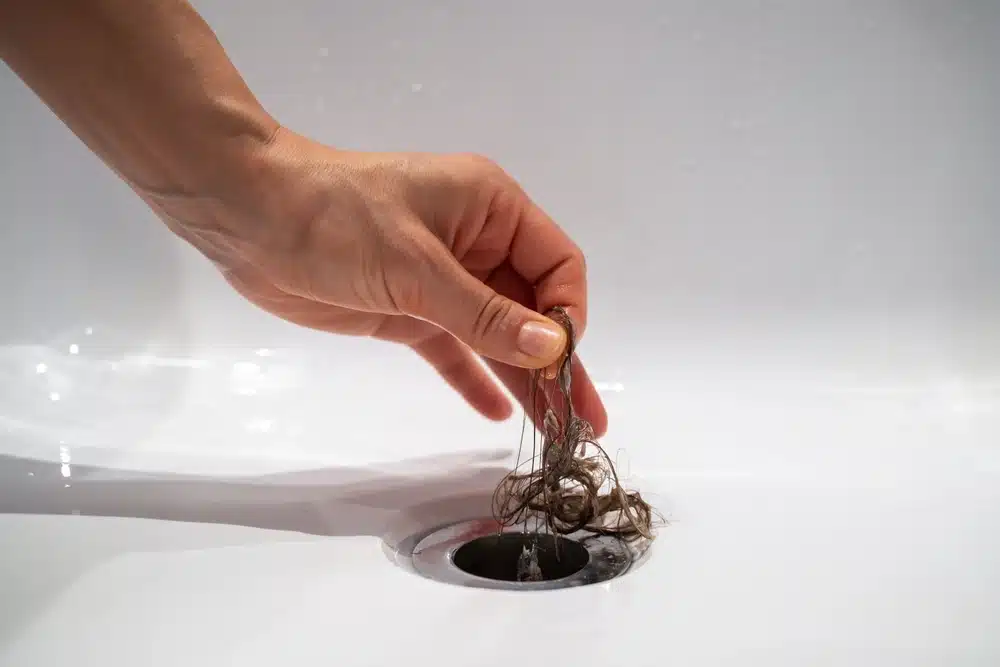Clip-in hair extensions are popular for multiple reasons. They provide the wearer with the appearance of thicker, longer, and often healthier hair, which can boost attractiveness and self-esteem. Plus, they are super simple to use and can be removed anytime.
It’s not all beautiful flowing locks, though, as clip-in extensions may be responsible for hair thinning and loss. So, how much truth is there to this? Are these hair extensions bad for your hair? Whether you are a beloved user of clip-in extensions or weighing up whether (or not) you should invest in some, this article is for you – find out all you need to know about the impact of clip-in extensions on hair loss.
What Are Clip-In Extensions?
First, let’s understand exactly what clip-in extensions are. Simply put, clip-in extensions are ready-to-wear hair with clips that you attach to the roots of your hair. They come in various colours and textures to blend seamlessly with the wearer.
Clip-in extensions vary in quality, too. You can find synthetic hair extensions, which do not look as natural and won’t last as long. Most people opt for high-quality real human hair extensions, as they can be styled and washed like your own tresses.
Not everyone wears the same types of hair extensions. Ther
Can Clip-In Extensions Cause Hair Loss?
So, can clip-in extensions cause hair loss? Unfortunately, yes: clip in hair extensions hair loss is quite common. Hair loss from clip-ins usually occurs when the person wears the hair extensions too often or does not properly place them in the hair. Over time, the weight and heft of the extensions pull at the hair shaft, causing strain and leading to traction alopecia.
About Traction Alopecia
Traction alopecia is a specific type of hair loss that occurs when there is too much strain on the hair. Over time, this repeated pulling motion on the hair follicles damages the root, eventually causing breakage. If this goes on too long, it can lead to permanent hair loss, where the hair will never grow naturally.
Clip-in extensions are not the only cause of traction alopecia; other popular tight hairstyles that cause it include:
- Cornrows
- Locs
- Tight Buns and Ponytails
- Locs
- Hair Weaves
- Rollers
Essentially, anything that tugs on the hair can lead to traction alopecia. Even using specific hair accessories can cause it if worn too often.
So – Should You Ditch the Clip-ins?
Not necessarily! When used properly, clip-in hair extensions can provide you with a beautiful head of long, luscious locks without too much effort. Whether you want to spruce up your look for a special event or wear them out on weekends, they can be a real confidence booster. Plus, there are ways to avoid traction alopecia when using them.
How to Avoid Hair Loss When Using Clip-In Hair Extensions
To avoid damage to your hair when using clip-in extensions, follow these tips to protect your strands.
Do Not Wear Them Every Day
The problem with clip-in hair extensions happens when the wearer uses them too often. While you might want to enjoy longer hair each day, wearing them every day will eventually lead to fewer natural locks, which you want to avoid. Give your hair a break occasionally; if you love wearing your extensions, even just one day a week without them can be beneficial.
Experiencing Hair Loss? Discover an Effective Hair Loss Treatment
Choose Lightweight Extensions
While many choose clip-in extensions for thicker hair, do not automatically pick out the heaviest set for your locks. Heavy hair extensions are the worst culprit for traction alopecia as they tug intensely at the hair follicles and often cause hair loss quickly. Instead, opt for a more lightweight option, spreading them out across your scalp so you distribute the tension.
Of course, consider your hair type here. Naturally thick hair may be able to withstand a heavier set, whereas fine hair should always choose the lightweight options.
Apply Them Correctly
Incorrectly applying clip-ins is bad for your hair and will cause more damage. So, learn how to use them correctly so that they stay put all day without tugging too hard at the scalp. You can find several informative videos online instructing you how to do this, so watch a few for the best techniques. Alternatively, ask a professional hair stylist to show you.
Always Take Them Out Before Sleep
Clip-in hair extensions are only meant to be worn during the day – you must always take them out before sleeping. Wearing them to bed can cause serious damage, as you will move your head across the pillow at night, causing more tension.
Treat Your Scalp Well
Nourish your scalp with a good hair care routine. Use gentle products, such as a sulphate-free shampoo, and avoid hot water. You can also use a soothing scalp serum or a leave-in conditioner. Remember always to rinse products out thoroughly to prevent build-up.
Be Careful When Brushing
After applying your clip-in extensions, you will likely brush them through to make them look like your natural hair. While this is an important step for your overall look, be careful, as brushing too hard will pull at your hair roots even more, increasing your chances of traction alopecia. So, be very gentle, avoiding the area where the clips attach to the roots.
Do Not Always Apply to the Same Area
If you have several clip-in extensions, start rotating them around the scalp, never applying them to the same area. If you consistently clip in the extensions to the same location, eventually, this will tug too hard at the strands and cause weakened hair that is more likely to break off.
Avoid Hair Extensions if You Have Weak Strands
Avoid hair extensions if you already experience thinning hair or frequent hair breakage. Clip-ins will only exacerbate the problem; treating the root cause of your thinning, breakable strands are best. Hair pieces or wigs are a good alternative if you feel less confident, as these do not pull at the strands so much.
When answering the question, “Do clip in extensions cause hair loss?”, the answer is yes, but it is much less likely if you follow these tips, as that way, you’ll minimise how much the hair extensions pull at your scalp.
Want to Monitor Hair Growth and Access Hair Restoration Treatments? Check out Our Hair Track App.
Can You Regrow Hair After Traction Alopecia?
Yes – you can often regrow your hair after experiencing traction alopecia. However, this is only possible with early intervention. Unfortunately, extensions can cause hair loss that is permanent, which means the hair follicles are permanently damaged and there’s no reversing it.
What To Do If You Have Permanent Hair Loss from Traction Alopecia
Not all hope is lost. There are hair growth methods that can help, including the following:
Hair Transplant Surgery: A hair transplant harvests healthy hair follicles and plants them into the problem area – in this case, where you have experienced traction alopecia. These follicles take root in their new home and grow new, natural hairs. It’s a permanent solution.
Minoxidil: Minoxidil can awaken dormant hair follicles by boosting blood flow to the scalp. It is a topical treatment you can purchase over the counter, and it’s often better known by its brand name, Rogaine.
Platelet-Rich Plasma Therapy: This therapy uses a patient’s blood to stimulate the hair follicles, and it works thanks to the growth factors in the plasma that boost growth.
Camouflage: There are several ways to camouflage hair loss caused by traction alopecia. You can change your hairstyle, get bangs, or even wear scalp makeup to cover the areas. It is not a permanent solution, but it can hide hair loss and restore confidence.
Are Other Types of Hair Extensions Better for the Hair?
We’ve now answered, “Can clip in extensions cause hair loss?”. So, what about other hair extension types?
Clip-in hair extensions are generally considered the best extensions to avoid damage. Other hair extension methods, such as semi-permanent hair extensions and permanent sewn-in weaves, can cause more damage. You’re better off sticking with the clip-ins.
Can Clip-In Hair Extensions Cause Hair Loss? Final Thoughts
The answer to, “Can clip in extensions cause hair loss?” is undoubtedly yes. However, that doesn’t mean you will inevitably experience hair breakage and fall out – if you wear hair extensions correctly and follow the advice above, you can enjoy wearing them without worry.
Have you experienced hair loss caused by hair extensions? We can help. Get in touch with our expert team to find out more about our hair restoration options, or check out our patients gallery to see the wonderful results our surgeons provide.




